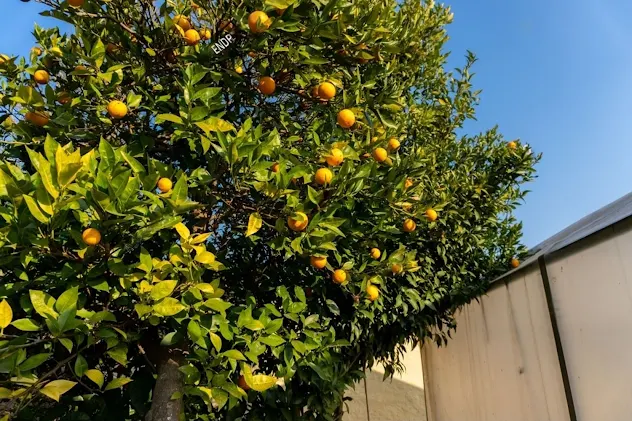From the category: tree
Friday, October 11, 2024
Introduction
The Malta fruit tree (Citrus sinensis), a member of the Rutaceae family, is a medium-sized evergreen tree known for producing sweet oranges. This comprehensive guide covers everything from its botanical characteristics to cultivation requirements.
Botanical Characteristics
Tree Structure
- Height: 20-30 feet (6-9 meters)
- Canopy spread: 15-20 feet (4.5-6 meters)
- Growth pattern: Rounded crown
- Trunk: Single main trunk
- Bark: Grayish-brown, smooth when young
- Lifespan: 50-100 years
Foliage
- Leaf type: Evergreen
- Leaf shape: Oval to elliptical
- Leaf size: 4-8 inches long
- Color: Dark glossy green
- Arrangement: Alternate
- Texture: Leathery
Flowering
- Bloom time: Spring
- Flower color: White
- Size: 1-2 inches in diameter
- Fragrance: Sweet, intense
- Pollination: Mainly by bees
- Flowering pattern: Annual
Growing Conditions
Climate Requirements
1. Temperature
- Optimal range: 15-30°C (59-86°F)
- Cold tolerance: Limited
- Heat tolerance: Moderate
- Frost sensitivity: High
2. Sunlight
- Full sun requirement: 6-8 hours daily
- Shade tolerance: Low
- Direction: South-facing preferred
3. Humidity
- Optimal range: 50-70%
- Air circulation: Important
- Moisture needs: Moderate
Soil Requirements
1. Soil Type
- Well-draining
- Loamy texture
- pH range: 5.5-6.5
- Organic matter: High
2. Soil Preparation
- Deep tillage
- Organic amendment addition
- Proper drainage system
- Regular soil testing
Planting Guidelines
- Site Selection
- Protected from strong winds
- Good air circulation
- Away from buildings
- Full sun exposure
- Proper spacing (15-20 feet apart)
Planting Process
1. Hole preparation
- Size: 2x root ball width
- Depth: Equal to root ball
- Soil amendment mixing
- Drainage checking
2. Timing
- Best season: Spring
- Alternative: Early fall
- Avoid extreme weather
- Consider local climate
Initial Care
- Regular watering
- Mulch application
- Stake if necessary
- Protection from animals
Tree Care and Maintenance
Watering Requirements
1. Young Trees
- Frequency: 2-3 times weekly
- Amount: 5-10 gallons
- Method: Deep watering
- Monitoring soil moisture
2. Mature Trees
- Frequency: Weekly
- Amount: 15-20 gallons
- Method: Drip irrigation
- Seasonal adjustments
Fertilization
1. Schedule
- Spring: Major feeding
- Summer: Light feeding
- Fall: Maintenance feeding
- Winter: No feeding
2. Nutrient Requirements
Nitrogen: High
Phosphorus: Moderate
Potassium: High
Micronutrients: Essential
Pruning
1. Timing
- Major pruning: Late winter
- Maintenance pruning: Year-round
- Post-harvest pruning
- Disease removal: As needed
2. Techniques
- Crown thinning
- Dead wood removal
- Shape maintenance
- Sucker removal
Common Problems
Diseases
1. Fungal Issues
- Citrus canker
- Root rot
- Sooty mold
- Prevention methods
2. Bacterial Problems
- Citrus greening
- Bacterial spot
- Treatment options
- Monitoring techniques
Pests
1. Common Insects
- Scale insects
- Citrus psylla
- Fruit flies
- Leaf miners
2. Control Methods
- Integrated pest management
- Biological control
- Chemical control
- Prevention strategies
Harvesting
Timing
- Season: Winter months
- Maturity indicators
- Picking methods
- Storage preparations
Techniques
1. Hand Picking
- Proper grip
- Twist and pull
- Tool usage
- Collection methods
2. Quality Assessment
- Color check
- Size evaluation
- Ripeness testing
- Damage inspection
Propagation Methods
Grafting
1. Techniques
- T-budding
- Shield budding
- Whip grafting
- Timing considerations
2. Rootstock Selection
- Disease resistance
- Size control
- Soil adaptation
- Yield influence
Other Methods
- Air layering
- Stem cuttings
- Seed propagation (not recommended)
- Tissue culture
Economic Aspects
Investment
- Initial costs
- Maintenance expenses
- Equipment needs
- Labor requirements
Returns
- Yield expectations
- Market value
- Break-even period
- Profit potential
Sustainable Practices
- Water Conservation
- Drip irrigation
- Mulching
- Water recycling
- Moisture monitoring
Organic Methods
1. Natural Fertilizers
- Compost
- Manure
- Green manure
- Organic amendments
2. Pest Control
- Beneficial insects
- Natural predators
- Organic sprays
- Cultural practices
Conclusion
Malta fruit trees require dedicated care but can be rewarding both for commercial growers and home gardeners. Success depends on understanding and meeting their specific needs while maintaining consistent care practices throughout their lifecycle.
Key Success Factors
- Proper site selection
- Regular maintenance
- Disease prevention
- Quality care practices
- Patience and dedication
- Continuous learning
This comprehensive guide provides a foundation for successful Malta fruit tree cultivation, whether for commercial production or home gardening purposes.
Subscribe to:
Posts (Atom)






Social Media